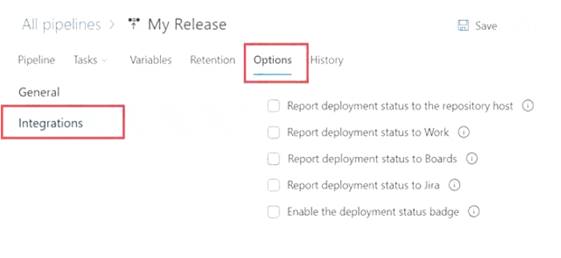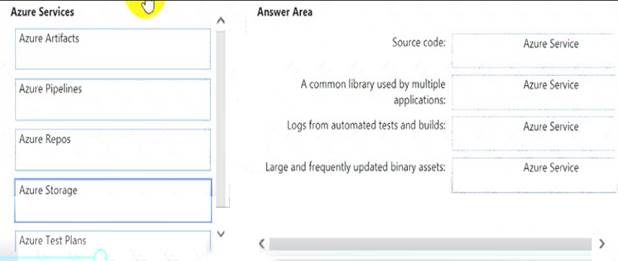Online AZ-400 Practice TestMore Microsoft Products >
Free Microsoft AZ-400 Exam Dumps Questions
Microsoft AZ-400: Microsoft Azure DevOps Solutions (beta)
- Get instant access to AZ-400 practice exam questions
- Get ready to pass the Microsoft Azure DevOps Solutions (beta) exam right now using our Microsoft AZ-400 exam package, which includes Microsoft AZ-400 practice test plus an Microsoft AZ-400 Exam Simulator.
- The best online AZ-400 exam study material and preparation tool is here.
Question 1
- (Exam Topic 2)
After you answer a question in this section, you will NOT be able to return to it. As a result, these questions will not appear in the review screen.
You use Azure Pipelines to build and test a React js application. You have a pipeline that has a single job.
You discover that installing JavaScript packages from npm takes approximately five minutes each time you run the pipeline.
You need to recommend a solution to reduce the pipeline execution time. Solution: You recommend enabling parallel jobs for the pipeline.
Does this meet the goal?
Correct Answer:B
Instead enable pipeline caching. Note:
npm-cache is a command line utility that caches dependencies installed via npm, bower, jspm and composer.
It is useful for build processes that run [npm|bower|composer|jspm] install every time as part of their build process. Since dependencies don't change often, this often means slower build times. npm-cache helps alleviate this problem by caching previously installed dependencies on the build machine.
Reference: https://www.npmjs.com/package/npm-cache
Question 2
- (Exam Topic 2)
You have an Azure DevOps project that contains a release pipeline and a Git repository. When a new code revision is committed to the repository, a build and release is triggered.
You need to ensure that release information for the pipeline is added automatically to the work items associated to the Git commit.
What should you do?
Correct Answer:B
Configure your release definition to post deployment information to Work items.
* 1. Open Pipelines>Releases, choose to edit your release pipeline, then choose Options>Integrations.
Reference:
https://docs.microsoft.com/en-us/azure/devops/boards/work-items/work-item-deployments-control
Question 3
- (Exam Topic 2)
You need to increase the security of your team's development process.
Which type of security tool should you recommend for each stage of the development process? To answer, drag the appropriate security toots to the correct stages. Each security tool may be used once, more than once, or not at all. You may need to drag the split bar between panes or scroll to view content NOTE: Each correct selection is worth one point.
Solution:
https://docs.microsoft.com/en-us/azure/devops/migrate/security-validation-cicd-pipeline?view=azure-devops&v So:
PR: Static Code Analysis CI: Static Code Analysis CD: PenTest
Does this meet the goal?
Correct Answer:A
Question 4
- (Exam Topic 2)
Your company uses Team Foundation Server 2013 (TFS 2013). You plan to migrate to Azure DevOps.
You need to recommend a migration strategy that meets the following requirements:  Preserves the dates of Team Foundation Version Control changesets
Preserves the dates of Team Foundation Version Control changesets Preserves the changes dates of work items revisions
Preserves the changes dates of work items revisions  Minimizes migration effort
Minimizes migration effort Migrates all TFS artifacts
Migrates all TFS artifacts
What should you recommend? To answer, select the appropriate options in the answer area. NOTE: Each correct selection is worth one point.
Solution:
Box 1: Upgrade TFS to the most recent RTM release.
One of the major prerequisites for migrating your Team Foundation Server database is to get your database schema version as close as possible to what is currently deployed in Azure Devops Services.
Box 2: Use the TFS Database Import Service
In Phase 3 of your migration project, you will work on upgrading your Team Foundation Server to one of the supported versions for the Database Import Service in Azure Devops Services.
References: Team Foundation Server to Azure Devops Services Migration Guide
Does this meet the goal?
Correct Answer:A
Question 5
- (Exam Topic 2)
You are building an application that has the following assets:  Source code
Source code Logs from automated tests and builds
Logs from automated tests and builds Large and frequently updated binary assets
Large and frequently updated binary assets A common library used by multiple applications
A common library used by multiple applications
Where should you store each asset? To answer, drag the appropriate Azure services to the correct assets. Each service may be used once. You may need to drag the split bar between panes or scroll to view content.
NOTE: Each correct selection is worth one point.
Solution:
Box 1: Azure Repos Box 2: Azure Artifacts
Use Azure Artifacts to create, host, and share packages with your team. Box 3: Azure Pipelines
In the pipeline view you can see all the stages and associated tests. The view provides a summary of the test results
Box 4: Azure Storage Reference:
https://docs.microsoft.com/en-us/azure/devops/repos/get-started/what-is-repos https://azure.microsoft.com/en-us/services/devops/artifacts/
https://docs.microsoft.com/en-us/azure/devops/pipelines/test/review-continuous-test-results-after-build
Does this meet the goal?
Correct Answer:A
Question 6
- (Exam Topic 2)
Note: This question is part of a series of questions that present the same scenario. Each question in the series contains a unique solution that might meet the stated goals. Some question sets might have more than one correct solution, while others might not have a correct solution.
After you answer a question in this section, you will NOT be able to return to it. As a result, these questions will not appear in the review screen.
You need to recommend an integration strategy for the build process of a Java application. The solution must meet the following requirements:
• The builds must access an on-premises dependency management system.
• The build outputs must be stored as Server artifacts in Azure DevOps.
• The source code must be stored in a Git repository in Azure DevOps.
Solution: Configure the build pipeline to use a Hosted Ubuntu agent pool. Include the Java Tool Installer task in the build pipeline. Does this meet the goal?
Correct Answer:A